2019 Hyundai Tucson fuel pressure
[x] Cancel search: fuel pressurePage 558 of 685
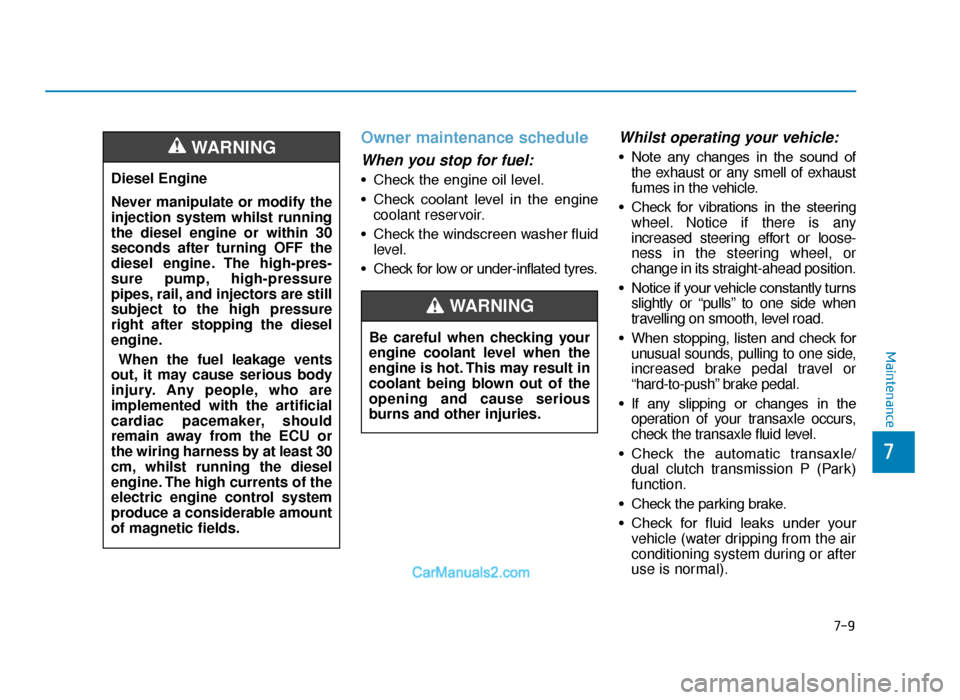
7-9
7
Maintenance
Owner maintenance schedule
When you stop for fuel:
• Check the engine oil level.
• Check coolant level in the enginecoolant reservoir.
• Check the windscreen washer fluid level.
• Check for low or under-inflated tyres.
Whilst operating your vehicle:
• Note any changes in the sound of the exhaust or any smell of exhaust
fumes in the vehicle.
• Check for vibrations in the steering wheel. Notice if there is any
increased steering effort or loose-
ness in the steering wheel, or
change in its straight-ahead position.
• Notice if your vehicle constantly turns slightly or “pulls” to one side when
travelling on smooth, level road.
• When stopping, listen and check for unusual sounds, pulling to one side,
increased brake pedal travel or
“hard-to-push” brake pedal.
• If any slipping or changes in the operation of your transaxle occurs,
check the transaxle fluid level.
• Check the automatic transaxle/ dual clutch transmission P (Park)
function.
• Check the parking brake.
• Check for fluid leaks under your vehicle (water dripping from the air
conditioning system during or after
use is normal).
Be careful when checking your
engine coolant level when the
engine is hot. This may result in
coolant being blown out of the
opening and cause serious
burns and other injuries.
WARNING
Diesel Engine
Never manipulate or modify the
injection system whilst running
the diesel engine or within 30
seconds after turning OFF the
diesel engine. The high-pres-
sure pump, high-pressure
pipes, rail, and injectors are still
subject to the high pressure
right after stopping the diesel
engine.
When the fuel leakage vents
out, it may cause serious body
injury. Any people, who are
implemented with the artificial
cardiac pacemaker, should
remain away from the ECU or
the wiring harness by at least 30
cm, whilst running the diesel
engine. The high currents of the
electric engine control system
produce a considerable amount
of magnetic fields.
WARNING
TLe UK 7.qxp 5/10/2018 1:32 PM Page 9
Page 561 of 685
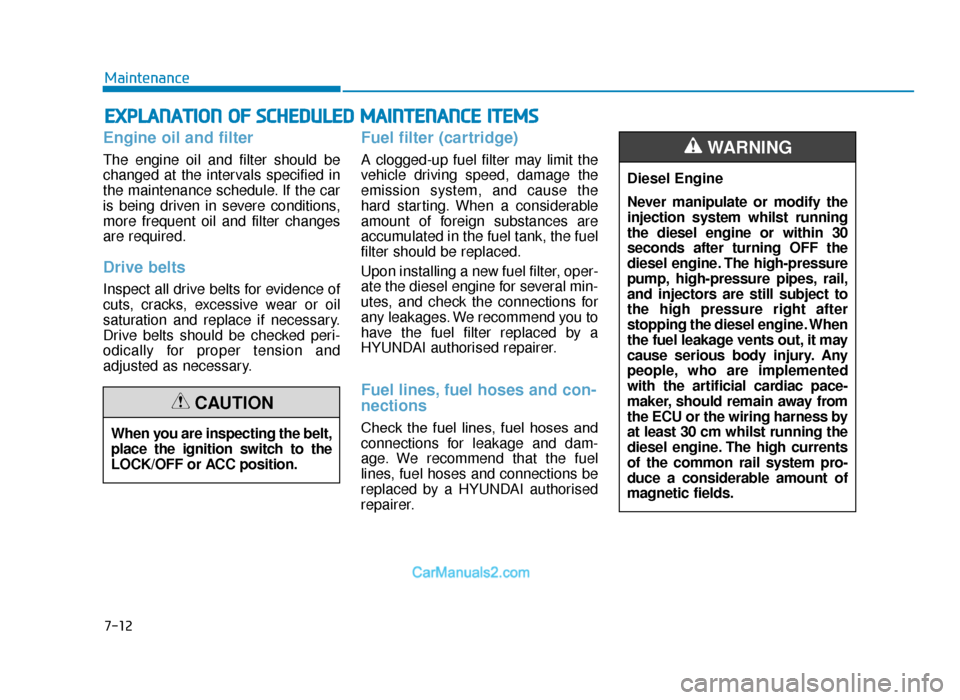
7-12
Maintenance
EXPLANATION OF SCHEDULED MAINTENANCE ITEMS
Engine oil and filter
The engine oil and filter should be
changed at the intervals specified in
the maintenance schedule. If the car
is being driven in severe conditions,
more frequent oil and filter changes
are required.
Drive belts
Inspect all drive belts for evidence of
cuts, cracks, excessive wear or oil
saturation and replace if necessary.
Drive belts should be checked peri-
odically for proper tension and
adjusted as necessary.
Fuel filter (cartridge)
A clogged-up fuel filter may limit the
vehicle driving speed, damage the
emission system, and cause the
hard starting. When a considerable
amount of foreign substances are
accumulated in the fuel tank, the fuel
filter should be replaced.
Upon installing a new fuel filter, oper-
ate the diesel engine for several min-
utes, and check the connections for
any leakages. We recommend you to
have the fuel filter replaced by a
HYUNDAI authorised repairer.
Fuel lines, fuel hoses and con-
nections
Check the fuel lines, fuel hoses and
connections for leakage and dam-
age. We recommend that the fuel
lines, fuel hoses and connections be
replaced by a HYUNDAI authorised
repairer.
When you are inspecting the belt,
place the ignition switch to the
LOCK/OFF or ACC position.
CAUTION
Diesel Engine
Never manipulate or modify the
injection system whilst running
the diesel engine or within 30
seconds after turning OFF the
diesel engine. The high-pressure
pump, high-pressure pipes, rail,
and injectors are still subject to
the high pressure right after
stopping the diesel engine. When
the fuel leakage vents out, it may
cause serious body injury. Any
people, who are implemented
with the artificial cardiac pace-
maker, should remain away from
the ECU or the wiring harness by
at least 30 cm whilst running the
diesel engine. The high currents
of the common rail system pro-
duce a considerable amount of
magnetic fields.
WARNING
TLe UK 7.qxp 5/10/2018 1:32 PM Page 12
Page 586 of 685
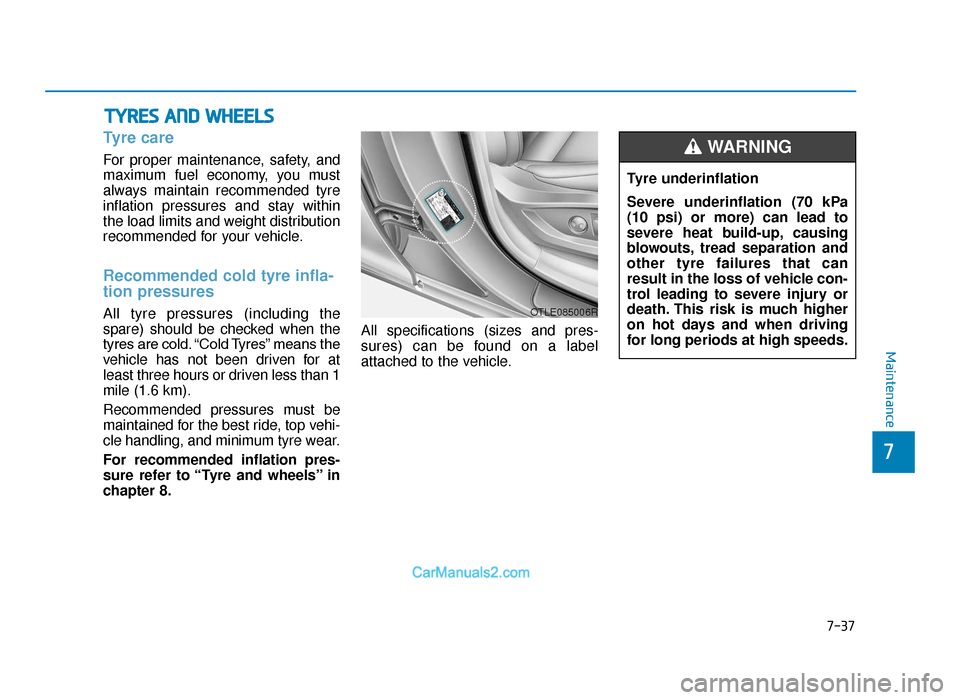
7-37
7
Maintenance
TYRES AND WHEELS
Tyre care
For proper maintenance, safety, and
maximum fuel economy, you must
always maintain recommended tyre
inflation pressures and stay within
the load limits and weight distribution
recommended for your vehicle.
Recommended cold tyre infla-
tion pressures
All tyre pressures (including the
spare) should be checked when the
tyres are cold. “Cold Tyres” means the
vehicle has not been driven for at
least three hours or driven less than 1
mile (1.6 km).
Recommended pressures must be
maintained for the best ride, top vehi-
cle handling, and minimum tyre wear.
For recommended inflation pres-
sure refer to “Tyre and wheels” in
chapter 8.All specifications (sizes and pres-
sures) can be found on a label
attached to the vehicle. Tyre underinflation
Severe underinflation (70 kPa
(10 psi) or more) can lead to
severe heat build-up, causing
blowouts, tread separation and
other tyre failures that can
result in the loss of vehicle con-
trol leading to severe injury or
death. This risk is much higher
on hot days and when driving
for long periods at high speeds.
WARNING
OTLE085006R
TLe UK 7.qxp 5/10/2018 1:34 PM Page 37
Page 587 of 685
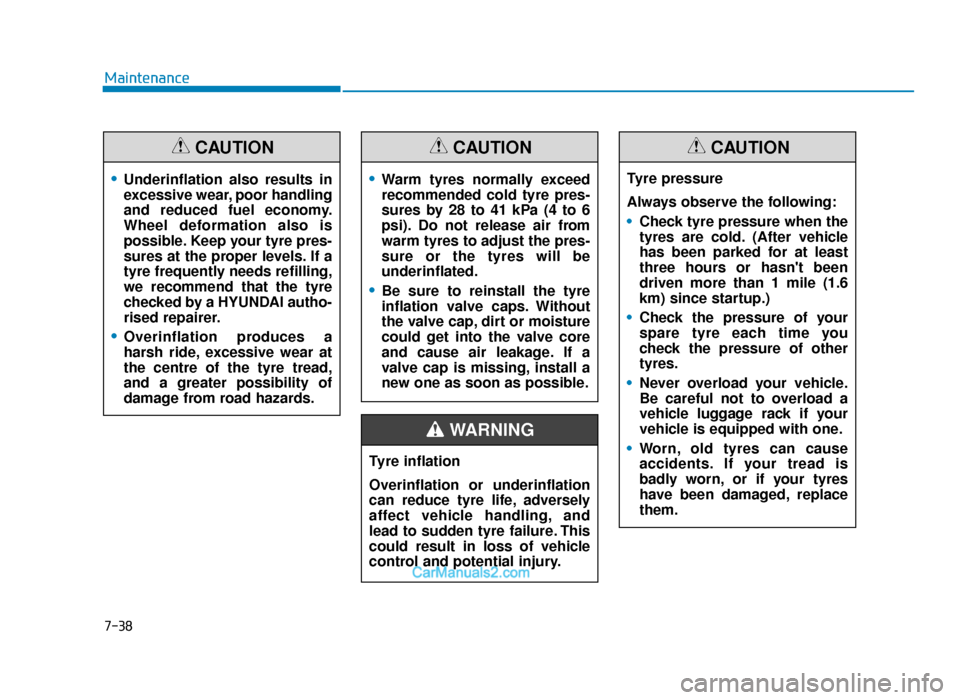
7-38
Maintenance
•Underinflation also results in
excessive wear, poor handling
and reduced fuel economy.
Wheel deformation also is
possible. Keep your tyre pres-
sures at the proper levels. If a
tyre frequently needs refilling,
we recommend that the tyre
checked by a HYUNDAI autho-
rised repairer.
•Overinflation produces a
harsh ride, excessive wear at
the centre of the tyre tread,
and a greater possibility of
damage from road hazards.
CAUTION
•Warm tyres normally exceed
recommended cold tyre pres-
sures by 28 to 41 kPa (4 to 6
psi). Do not release air from
warm tyres to adjust the pres-
sure or the tyres will be
underinflated.
•Be sure to reinstall the tyre
inflation valve caps. Without
the valve cap, dirt or moisture
could get into the valve core
and cause air leakage. If a
valve cap is missing, install a
new one as soon as possible.
CAUTION
Tyre pressure
Always observe the following:
•Check tyre pressure when the
tyres are cold. (After vehicle
has been parked for at least
three hours or hasn't been
driven more than 1 mile (1.6
km) since startup.)
• Check the pressure of your
spare tyre each time you
check the pressure of other
tyres.
• Never overload your vehicle.
Be careful not to overload a
vehicle luggage rack if your
vehicle is equipped with one.
• Worn, old tyres can cause
accidents. If your tread is
badly worn, or if your tyres
have been damaged, replace
them.
CAUTION
Tyre inflation
Overinflation or underinflation
can reduce tyre life, adversely
affect vehicle handling, and
lead to sudden tyre failure. This
could result in loss of vehicle
control and potential injury.
WARNING
TLe UK 7.qxp 5/10/2018 1:35 PM Page 38
Page 614 of 685

7-65
7
Maintenance
Fuse Name SymbolFuse ratingCircuit Protected
FUSE
SENSOR 115A
G4NA/G4KJ : Oxygen Sensor (Up/Down)
G4FD : PCM/ECM, Oxygen Sensor (Up/Down)
G4FJ : ECM, Oxygen Sensor (Up/Down)
D4HA/D4FE : Electronic VGT Actuator (D4HA), Lambda Sensor #1/#2, PM Sensor,Mass Air Flow Sensor (D4FE), Fuel Pressure Regulating Valve
(D4HA), Oil Pump Solenoid Valve (D4FE), Stop Lamp Switch (D4FE)
ECU 220A G4NA/G4FD : Ignition Coil #1/#2/#3/#4, Condenser, G4FJ : Ignition Coil #1/#2/#3/#4, D4HA/D4FE : ECM
ECU 515A G4FD : PCM/ECM, G4FJ : ECM
ECU 415A G4NA/G4FD : PCM/ECM, G4FJ/D4HA/D4FE : ECM, G4KJ : PCM
SENSOR 310A
G4NA/G4FD/G4KJ : Injector #1/#2/#3/#4 (G4NA), E/R Junction Block (RLY. 1, RLY.9)
G4FJ : RCV Control Solenoid Valve, Brake Booster Vacuum Pressure Switch, E/R Junction Block (RLY. 1, RLY.9)
D4HA/D4FE : Mass Air Flow Sensor (D4HA), Oil Pump Solenoid Valve (D4HA), E/R Junction Block (RLY. 1, RLY.9), Electronic VGT Actuator (D4FE)
H/LP
WASHER20AE/R Junction Block (RLY. 12)
DEICER15A E/R Junction Block (RLY. 8)
Engine compartment main fuse panel (PCB Block)
TLe UK 7.qxp 5/10/2018 1:38 PM Page 65
Page 657 of 685
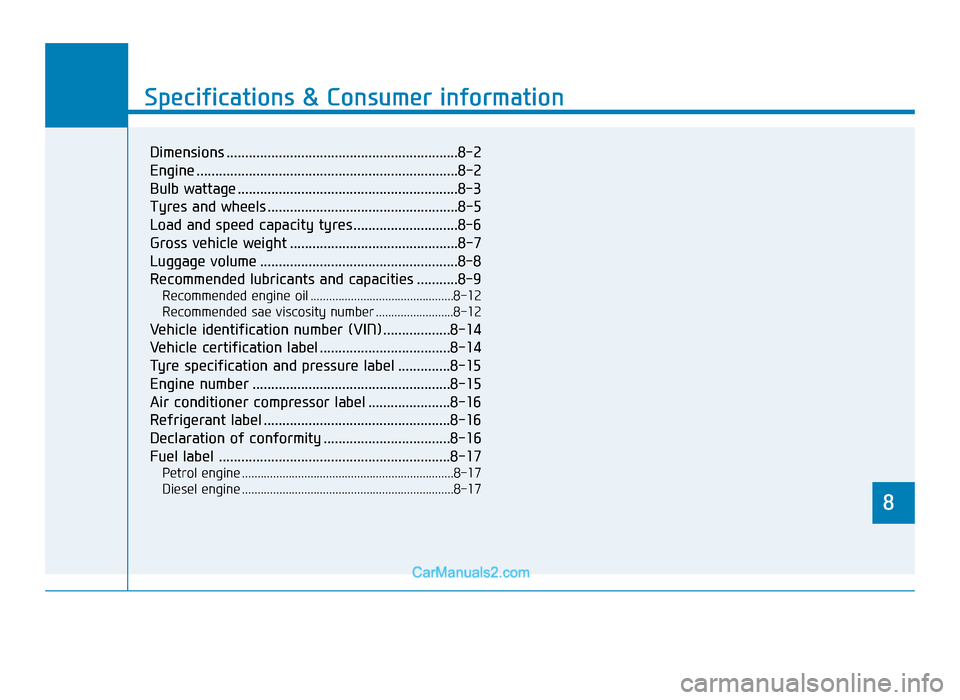
8
Specifications & Consumer information
8
Specifications & Consumer information
8
Dimensions ..............................................................8-2
Engine ......................................................................8-\
2
Bulb wattage ...........................................................8-3
Tyres and wheels ...................................................8-5
Load and speed capacity tyres ............................8-6
Gross vehicle weight .............................................8-7
Luggage volume .....................................................8-8
Recommended lubricants and capacities ...........8-9
Recommended engine oil ..............................................8-12
Recommended sae viscosity number .........................8-12
Vehicle identification number (VIN) ..................8-14
Vehicle certification label ...................................8-14
Tyre specification and pressure label ..............8-15
Engine number .....................................................8-15
Air conditioner compressor label ......................8-16
Refrigerant label ..................................................8-16
Declaration of conformity ..................................8-16
Fuel label ..............................................................8-17
Petrol engine ....................................................................8-17\
Diesel engine ....................................................................8-17\
TLe UK 8.qxp 6/12/2018 3:30 PM Page 1